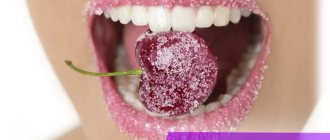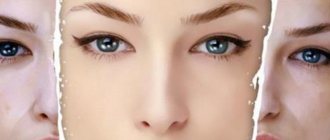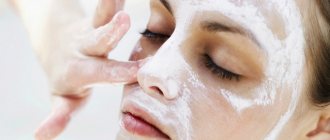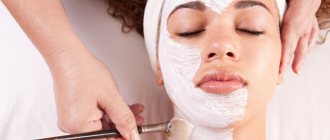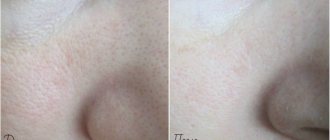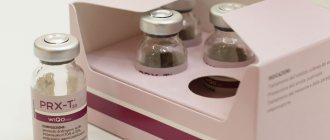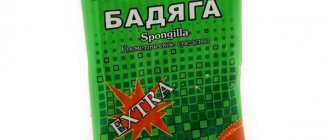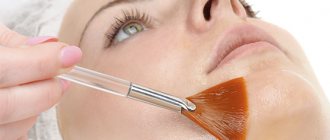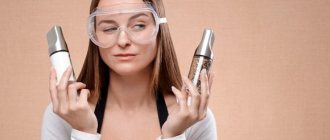Using a glycolic acid peel as a DIY facial at home will not only cleanse your pores, but the mixture also has a rejuvenating, whitening, and moisturizing effect on the dermis.
To get the maximum positive effect from the procedure at home, you must first consult with a qualified specialist, familiarize yourself with the rules for exfoliation, precautions and available contraindications.
The essence of peeling
Glycolic or hydroxyacetic acid belongs to the category of fruit acids - it is obtained from beets or sugar cane. The molecules of this substance are small in size, which allows them to penetrate into the deep layers of the skin and effectively remove impurities of varying complexity.
After applying the composition with glycolic acid, the active substance begins to affect the skin, promoting:
- effective removal of the keratinized layer of cells;
- stimulation of the natural regeneration process;
- saturation of dermal cells with oxygen;
- evening out complexion and skin texture.
Properties of glycolic acid
Hydroxyacetic acid is of plant origin, it is obtained from sugar cane, beets or grapes. The small size of molecules and low molecular weight allow the exfoliant to quickly and deeply penetrate the integument, right down to the dermis. These properties are responsible for the pronounced effect after the procedure.
Glycolic acid acts simultaneously in several directions:
- cleanses - the molecules of the substance destroy the connections between keratinized cells and promote their removal. As a result, the skin becomes softer, the relief is smoothed;
- rejuvenates - the drug activates the natural regeneration mechanism of the skin, increases the firmness and elasticity of the fibers;
- has an anti-inflammatory effect, so glycolic cleansing is often used to prevent acne;
- moisturizes, thanks to the ability of hydroxyacetic molecules to retain moisture particles;
- increases the protective properties of the skin;
- whitens the skin by removing accumulations of melanin.
Hydroxyacetic acid is considered one of the favorite fruit acids of cosmetologists and clients of beauty salons. The gentleness of the impact along with the pronounced effect are the main advantages of the procedure.
Indications for use
Recommendations for performing glycolic exfoliation:
- expression and age wrinkles;
- loss of elasticity;
- dark spots;
- signs of photoaging of the skin;
- shallow scars;
- excessive production of subcutaneous sebum;
- enlarged pores;
- severe peeling;
- blackheads or non-inflamed pimples.
At home, you can prepare the skin with glycolic peeling for deeper exfoliation or facial plastic surgery.
Advantages and disadvantages
Chemical peeling is a popular type of cosmetic procedure for cleansing and rejuvenating the skin. A pronounced effect and an affordable price are its main advantages.
Among the advantages of glycolic peeling it is also worth highlighting:
- soft and deep cleansing;
- versatility - suitable for dry, combination, oily, problem skin at any age;
- does not require anesthesia;
- characterized by an easy course of rehabilitation, rarely accompanied by complications;
- can be performed at home.
There are also disadvantages:
- restoration of the integument will take some time, special care will be required;
- ineffective against deep wrinkles, tissue ptosis;
- a single procedure will not provide the desired, long-term result; a course of peelings will be required;
- there is a risk of complications if exfoliation is performed incorrectly;
- has contraindications.
Contraindications
There are a number of contraindications for performing glycolic exfoliation:
- rosacea;
- recent tanning;
- pronounced capillary network;
- wounds or inflamed pimples;
- active form of herpes;
- carrying a child or breastfeeding;
- moles and warts;
- heart or vascular disease;
- dermatitis;
- asthma;
- oncological diseases;
- diabetes.
Expert opinion
Elena Apostolyuk
Cosmetologist
Self-peeling should not be done for dry or combination types of epidermis, since the incorrect concentration of the active substance can lead to a deterioration of the initial condition of the skin.
Effort and work
Greykann Svendsen, celebrity cosmetologist at Shafer Plastic Surgery
, claims that in order to get a visible effect from a fabric mask, you need to find the ideal one and use it with enviable regularity. A cosmetologist often notices that people with dry skin choose a drying mask, although they clearly need a moisturizing one. “In addition, patients with acne often dry out their skin using masks. This negatively affects the state of the hydro-lipid barrier of the microbiome, which is important for protecting the skin,” adds Greikann Svendsen. Simply put, you definitely shouldn’t overdo it with masks, even fabric ones: as they say, less is more.
Anti-aging face mask with black bean extract No Wrinkles, Cettua; highly concentrated nicotinamide fabric mask “Detox”, Garnier.
Efficiency of the procedure
After glycolic exfoliation, the following positive changes are observed:
- the color and texture of the skin is evened out;
- the production of collagen fibers is activated;
- the number of acne decreases;
- pores narrow;
- the production of subcutaneous sebum is normalized.
Properly performed at home peeling using glycolic acid will not only improve the appearance and restore health of the skin, but also slow down the aging process. To obtain a visible effect, it is necessary to undergo a course of cleansing - it is recommended to calculate the number of procedures and the optimal concentration of the active component together with a cosmetologist.
How does acid affect the skin?
In order to understand the reasons for the rejuvenating effect of milk peeling, it is necessary to clarify some aspects of the physiology and anatomy of the skin. The structure of the skin is divided into 3 sections:
- epidermis (topmost layer);
- dermis (actual skin);
- hypodermis (subcutaneous fat tissue).
In this case, the epidermis consists of 5 layers of cells: basal, spinous, granular, shiny, horny.
Aging skin undergoes a number of changes that occur primarily in the dermis and epidermis. Over time, the layers of the skin become thinner and droop, and in addition, solar radiation has a strong negative effect on aging skin. This damage leads to various problems:
- thickening of deformed skin folds;
- solar elastosis;
- uneven pigmentation.
Carcinogenic effects lead to actinic keratoses, basal and squamous cell carcinomas and, to a lesser extent, melanomas.
Scars accumulated over a lifetime from injuries or acne lead to additional changes in skin texture. True age-related skin laxity in the form of drooping eyebrows, bags on the eyelids, jowls and loss of cleavage, lengthening of the earlobe, drooping of the tip of the nose, thinning of the upper lip and other manifestations are now treated surgically through facial rejuvenation procedures (eg, facelift, facelift eyebrows, rhinoplasty, lip augmentation). Conversely, these treatments do not help with textural damage to the skin. Fine wrinkles, large pigmentation irregularities and aging skin are treated with peeling using chemical or mechanical means.
How to prepare a glycolic peel at home
Recipes for effective acid cleansing mixtures:
- Oatmeal. Boil 1-2 tbsp. l. oatmeal until it becomes porridge, cool it and add 25 g of cane sugar. Immediately spread the mixture over your face, massage for a few minutes, and after 10–15 minutes, remove the residue with a damp cloth.
- Protein. Mix egg white with 20 ml of cream and 20 g of cane sugar. Apply to the skin, massage, remove any residue with a cloth previously moistened in mineral water.
- Yolk. Combine 20 g of cane sugar with egg yolk and pureed aloe leaf. Apply to skin, rinse with cold water after 15–20 minutes.
- Lemon. Add 20 g of sugar to 30 ml of lemon juice, apply to face, rinse with water after 15 minutes.
After using any of the cleansing mixtures, you must apply a cream that has a nourishing, moisturizing and anti-inflammatory effect.
Let's rejuvenate slowly
Chemical peeling of the face with glycolic acid at home should bring real pleasure both to the process itself and to the end result. Therefore, it is important to carry out the procedure correctly.
Preparation
About 2-3 weeks before the glycolic peel itself, we will introduce the skin to it. To do this, simply use night creams and tonics with 4-5% organic acid (citric, lactic, almond, glycolic, retinoic) for facial care. Use these remedies once a day.
In this way, we adapt the epidermis to the effects of acids and slightly thin the top layer of skin, making it more permeable.
Carrying out at home
Stages of performing glycolic peeling at home:
- You must first cleanse your face of makeup, dirt and grease using liquid ichthyol soap, milk with hyaluronic acid or other cleansing gels. They are evenly distributed with massage movements for 2-3 minutes, after which they are carefully removed with a napkin soaked in water at room temperature.
- Applying a warming and cleansing lotion with 5% glycolic acid, which causes redness and a slight burning sensation, dissolves remaining fat, and evens out the acid-base environment on the surface of the skin. It is applied along massage lines, after which it is immediately washed off with napkins soaked in cool water.
- Direct application of the peeling preparation - 10-15% glycolic gel or lotion. It is applied with a special fan brush with wide movements or with two cotton swabs in a circular motion, starting from the forehead and ending with the chin. Lastly, the acid is carefully applied to the eyelids, avoiding getting it into the eyes. After this, a light skin massage is carried out in front of the mirror using cotton swabs, focusing on wrinkles, pigmented areas, small scars, in the corners of the eyes, and in the bridge of the nose. Glycolic peeling exposure time is 10-15 minutes.
- The peeling mixture is washed off with regular cool water. If areas of pronounced redness appear during the peeling process, the acid in these areas can be neutralized with a special neutralizing gel. If redness occurs in 3 areas, it is necessary to neutralize the acid on the entire face. If the burning continues, the neutralization procedure is repeated and everything is washed off with cool water.
- Application of lactolan peeling cream, consisting of 80% specially processed whey containing proteins, milk proteins, a small percentage of lactic acid and extracts resulting from the fermentation of cheese. The cream is applied with fingertips with light massage movements. It combines the properties of peeling-gommage and enzyme peeling, relieves skin reactivity, tingling and burning, “calms” it and provides it with nutritional components. Apply a compress on top of the cream for 10-15 minutes using napkins soaked in warm water. Then the cream must be washed off under warm running water and the skin dried.
- Applying a mask. You can use any moisturizing or restoring cream as it. It is applied for the time specified in the instructions for it, after which it is washed off and a nourishing cream is applied, which is usually used at home.
The procedure for superficial peeling at home using glycolic acid takes about 1 hour. It is especially effective in people 25-30 years of age, but is also quite suitable for older people.
Glycolic peeling at home must be carried out in courses (6-8 procedures):
- for oily skin once a week;
- for dry – once every two weeks.
The exposure time can be increased for each subsequent procedure by 2 minutes. But exposing the skin to organic acids for more than 10 minutes is strictly prohibited!
Video of AHA-acid peeling (glycolic acid also belongs to fruit, so the rules are the same)
What to do after
Renewed skin will require a little more care and attention. For the next three days, do not wear makeup, and regularly lubricate your face with moisturizer or serum.
Attention, after glycolic peeling you should not:
- Go to the solarium and sauna at this time! High temperatures and ultraviolet exposure can have a catastrophic effect on the skin after a chemical peel.
- Within two hours after the procedure, use any cosmetic products, except post-treatment.
After each peeling procedure at home, apply soothing compresses:
- From celandine. Pour boiling water over 10 grams of herbs, cook over low heat for 10 minutes. Cool the healing pulp and apply to the treated areas of the face. Place damp gauze soaked in herbal infusion on top. Keep the compress for a quarter of an hour.
- Green tea. We need a brew of green tea (12 g), which is brewed in a liter of boiling water. Let it sit for a quarter of an hour, then wet the gauze and apply it to the face.
After peeling at home, it is imperative to apply rich protective creams before going outside (ideally, if the protection level is 25 units). Your skin will be flaky for the first week. You can't exfoliate it by hand! Otherwise, scars may appear.
Preparatory stage
Before doing glycolic peeling yourself at home, you should apply a cream containing glycolic acid to your skin daily for 5–7 days before exfoliation. The period of preparing the skin for exfoliation significantly reduces the risk of side effects and reduces the duration of the recovery period.
Before applying any cleansing mixture, it is necessary to do a test to identify an allergic reaction - to do this, apply a small amount of the composition to the bend of the elbow and leave it for 20-30 minutes. If during this time there is no severe redness, itching or burning, you can use the drug to perform a cleansing procedure.
How does the molecule of youth work?
Glycolic peeling at home is the treatment of the outer layer of skin with a solution of glycolic acid. It completely removes the keratinized, superficial layer of the dermis (along with dirt, dead cells and accumulated toxins). The most valuable thing that peeling is aimed at is the activation of internal processes of the body: accelerating the processes of cellular regeneration, the production of collagen, elastin and hyaluronic acid. But these are not all the talents of glycolic acid:
- exfoliation of the upper layer of the epidermis;
- regulation of sebum production;
- excellent moisturizing effect;
- thorough smoothing of fine wrinkles;
- protecting the skin from sun exposure (photoaging);
- face whitening, pigmentation reduction;
- acne treatment;
- strengthening of the general tone.
When the top layer of the epidermis is destroyed, the body begins to actively synthesize its own collagen, giving life to new, strong cells. The skin is reborn, clean and healthy. Impressive? You will also be impressed by the fact that only 6-8 sessions of glycolic peeling are enough to completely rejuvenate the dermis. Also, glycolic peeling at home will help significantly smooth out stretch marks and post-acne scars.
After a course of glycolic peeling (7 procedures)
1. Immediately after peeling with a 30% glycolic acid solution 2. Skin peeling 3. After recovery
Main stages of the procedure
Glycolic exfoliation involves several steps:
- Surface impurities are removed using a soft, alcohol-free lotion - this will allow the active ingredients to penetrate into the deeper layers of the skin.
- A thin layer of glycolic acid is applied to the face, with a concentration of no more than 5%.
- Distribute the main mixture evenly. The cleanser should be left on for 1–5 minutes for the first time; in subsequent procedures, you can gradually increase the duration to 30 minutes. For severe skin defects, glycolic acid is applied in several layers - this can lead to tingling and burning.
- Use the neutralizer that comes with the finished peeling kit, or a weak alkali solution - this will help avoid burns. Wash with warm water and pat your face with a dry cloth.
After exfoliation is completed, it is necessary to apply a nourishing mask and sunscreen - this will help normalize the water balance, have a nourishing effect and reduce the risk of age spots.
Exfoliation efficiency
Facial peeling with glycolic acid cannot guarantee significant skin rejuvenation and smoothing of all age-related wrinkles and deep scars. For this, cosmetology offers more complex anti-aging procedures, such as laser resurfacing, deep peeling, and plastic surgery.
After a course of exfoliation with hydroxyacetic acid, you should expect the following changes:
- the complexion is evened out and improved;
- the skin texture becomes smoother and smoother;
- the elasticity of the fibers increases;
- acne on the face decreases, the skin becomes clean and looks healthy;
- pores become narrower, the greasiness of the integument decreases.
Cleansing with glycolic acid can improve the quality of the skin in all directions, and for more mature clients it can delay aging and rejuvenate the appearance.
Important point! To achieve a pronounced effect, one procedure is not enough. Cleansing is carried out in courses.
The duration of therapy depends on several factors, including the client’s age, sensitivity of the integument, and their primary condition. The course of superficial cleansing involves 3–10 sessions with an interval of 7–10 days. To refresh young skin and improve its color, 2-3 sessions are enough. Medium peels should be done once every 3 months. The number of procedures is determined only by the cosmetologist.
Healing period
It is important to follow a number of recommendations for skin care after cleansing:
- the first day, do not wash your face or touch your face with your hands;
- cleanse the skin with delicate products without alcohol;
- Use sunscreen on your face before every time you go outside;
- Do not remove crusts that appear on your own;
- stop using scrubs for several weeks;
- refuse decorative cosmetics for the entire period of rehabilitation;
- avoid visiting a bathhouse, solarium or sauna;
- avoid excessive physical activity.
For 3-5 days, it is recommended to spend less time outside - strong winds, sun rays or sudden changes in weather can lead to severe peeling. To shorten the recovery period, you should apply a product with a moisturizing, anti-inflammatory and wound-healing effect daily.
Glycolic peeling course: features of procedures
A classic glycolic peeling course consists of six procedures. The first two are carried out with 30% glycolic acid, which cleanses the epidermis and the openings of the sebaceous glands and prepares the skin for deeper effects. The procedure may be perceived as quite painful (there may be a tingling and burning sensation), but there will be no “burn” or redness of the skin after neutralization of the acid. The only “side effect” of peeling is increased peeling of the skin for several days.
The third and fourth procedures are glycolic peeling with a 50% solution. Many people think that this procedure is much more difficult to tolerate than initial superficial peels, but this is not so. Unpleasant sensations during application of the solution are possible, but their severity is insignificant. And you will be pleased to know that glycolic peeling with 70% acid is even easier to tolerate - there is no or minimal burning sensation. Another unique feature of glycolic acid.
The procedure itself is carried out according to the standard scheme. Makeup removal is carried out, the skin is cleansed of fat and minor impurities with glycolic acid diluted to 4-5%. Then the stock solution of the selected concentration is applied. After exposure, the acid is neutralized with an alkaline solution, the skin is treated with products with a calming and moisturizing effect (first a mask, then a cream).
The procedures are carried out at intervals of 7-14 days. The frequency of exposure is determined by a cosmetologist based on skin type, age and indications. During the course you need to avoid solariums and preferably spend less time in the sun (we recommend doing glycolic peeling in the cold season). You will learn more about the features of skin care during a course of procedures during a consultation with a cosmetologist at the SOHO CLINIC. Make an appointment. Take care of the youth, health and beauty of your skin.
Precautionary measures
Precautions to help avoid side effects:
- refuse to perform cleaning if the temperature rises and general health deteriorates;
- avoid contact of the acid mixture with the area around the eyes and lips;
- apply peeling using a cosmetic brush or cotton pad;
- perform procedures wearing sterile gloves.
If, after applying the acidic composition, a strong burning sensation occurs, you should immediately apply a neutralizer and rinse off the mixture, and then select a different concentration of the active substance with a cosmetologist.
Types of glycolic peeling
It can be performed in two versions:
- Superficial or gentle . The acid used is 40% concentration. Recommended for whitening, fighting inflammation, and reducing fine wrinkles. Advantages include possible regular use and emergency use.
- Aggressive . The acid in this case is taken from 40% to 70%. The process of cell regeneration starts in the deepest layers of the skin. Pain, peeling, redness, and dryness often appear. The effect is much higher than with superficial, but the risk of complications is higher.
Cosmetologists' opinion
- Ekaterina Dudikova, dermatologist, cosmetologist: “Glycol cleansing helps to cope with many skin problems, but I do not advise my clients to independently select the concentration of the substance for themselves. Most people want to get a positive effect in the shortest possible time, so they overdo it with the active ingredient. As a result, existing defects get worse, new problems appear, and then the specialist has to work for a long time to cure the skin.”
- Anastasia Zaslavskaya, dermatologist, cosmetologist: “I believe that at home you can use ready-made preparations with a low content of glycolic and other acids - this way you can maintain the health of the dermis and do not harm it.”
Peeling at home
Peeling is a fairly common skin cleansing procedure. You can buy a ready-made product for this or make it yourself. Although, of course, it’s easier to purchase a peeling kit in pharmacies, specialty stores and even supermarkets. When choosing, it is important to focus on the composition, expiration date and manufacturer.
What kind of acid is this?
Acid group
Glycolic or hydroxyacetic acid belongs to the fruit group, and peeling is considered chemical, although mild and gentle. In nature, acid can only be found in cane, beets and unripe grapes.
There is another name - essence of youth. It has rapid permeability through the upper skin due to its low molecular weight. In cosmetics the concentration ranges from 3 to 10%. For peeling, a concentration of 40% to 80% acid is used.
At home, cleansing with glycolic acid allows you to remove dead skin cells, dirt particles, and toxins through surface treatment of the skin.
Until recently, peeling was done only in beauty salons, but today women can take care of themselves at home using special products and instructions for use.
Action of glycolic acid
Launches internal processes in the body;- increases cell regeneration;
- promotes collagen production;
- cleanses;
- reduces sebum production;
- moisturizes;
- smoothes wrinkles;
- has protective properties against ultraviolet radiation;
- reduces pigmentation;
- relieves acne;
- tones.
As soon as the top layer of skin is destroyed, the body starts the process of producing its own collagen. Thanks to this process, the skin is renewed and looks healthy and fresh.
Effect after peeling
It comes on very quickly - within a few hours.
Who is glycolic acid peeling suitable for?
Specialists in beauty salons are confident that such acid peeling is suitable for any skin - both light with freckles and dark. The only difference will be in the concentration of the solution. But, in any case, glycolic acid has a mild effect, affecting only the surface layer of the skin.
Cases when acid peeling can be used:
- after therapy aimed at getting rid of acne, scars, spots;
- in the fight against age-related changes;
- if desired, remove age spots and freckles;
- to remove the top layer of skin;
- to increase skin elasticity;
- pronounced enlarged pores and increased sebum secretion.
In other cases, there is no point in doing an acid glycolic peel. And of course, you shouldn’t expect it to solve problems with scars and deep wrinkles, but it can make them less noticeable. For people over 50 years old, such rejuvenation and cleansing will not be effective, but up to 45 years old it can be safely practiced.
Skin testing
Before starting peeling, it is necessary to check the skin for allergies to the constituent substances. To do this, you need to apply the product to the skin around the elbow or wrist for 10 minutes.
If you feel a tingling or burning sensation, the solution is not considered allergenic. But, if the burning sensation becomes severe, the skin turns red, swelling or itching appears, then the solution is strictly forbidden to apply to the face.
When should the product not be used?
Glycolic acid has several strict contraindications. Among them:
- pregnancy;
lactation;- asthma;
- cardiac and vascular pathologies;
- diabetes;
- wounds and inflammations on the skin;
- herpes;
- warts, papillomas and other formations;
- high skin sensitivity;
- allergy to acids;
- fever;
- oncology.
It is not recommended to perform peeling if hair removal or tanning was performed a few days before the procedure.
Undesirable consequences
Side effects appear with a high concentration of acid in the solution, or with prolonged exposure to the skin. It can be:
- Swelling that appears a few hours after peeling. It goes away on its own, but requires further caution.
- Burn with redness. To smooth out the symptoms, you can simply wash your face with cold water and moisturize with a cream with a soothing effect.
- Allergy. Despite testing before the procedure of applying acid to the face, sometimes it happens that the test was successful, but an allergy appeared during peeling. Then you urgently need to take an antihistamine and further use of acid peeling is prohibited.
- Increased pigmentation.
- Dry skin, peeling. To avoid this in the future, it is recommended to dilute the acid even more and be sure to use a rich moisturizer.
Patient reviews
- Katya, 25 years old: “I did a course of cleansing with a composition with a 10% acid concentration - I performed 5 procedures with an interval of 10 days. As a result, the skin texture was evened out, the number of acne and age spots decreased. During rehabilitation, redness and peeling were observed, but it went away after 6 days. I was pleased with the effect, and if necessary, I will continue to do similar exfoliations.”
- Marina, 35 years old: “I’m 35 years old and I have dry skin, so I try not to do peeling at home. At the beauty salon, a specialist recommended glycolic peeling to me - I did 4 procedures in 2 months. Now I can confidently recommend this type of cleansing to other people - the severity of age and facial wrinkles has significantly decreased, pores have narrowed, and skin elasticity has increased.”
- Lena, 27 years old: “Now I only get peeling from cosmetologists, because due to my own stupidity I have worsened the condition of my skin. I used a mixture with glycolic acid, but I chose the wrong concentration - this led to severe peeling and burns. Then I had my skin treated by a specialist for almost six months. Therefore, girls, don’t make my mistakes - even if you decide to cleanse yourself, be sure to consult a dermatologist.”
Following all recommendations for preparing the dermis, cleaning and further caring for the skin will help get rid of existing problems and maintain the health of the dermis for a long time.
For facial skin peeling at home, formulations with a small content of glycolic acid are recommended - improper use of a mixture with a high concentration of the active component can lead to burns or aggravation of the initial condition.
Rating
Glycolic peeling: history and science
Glycolic facial peels were the subject of a large scientific study conducted in 1996. Scientists studied the effect of a 50% acid solution on skin with signs of photoaging. The results of the experiment exceeded expectations. After a course of procedures, the severity of the manifestations of photoaging significantly decreased, the skin began to look younger, fresher, and its color improved.
Visual changes were confirmed by biopsy data. The number of living cells in the epidermis has increased significantly, the number of collagen fibers in the dermis has increased, and its hydrophilic properties (hydration) have improved. There was also a decrease in sebum production in people with oily skin and a normalization of the composition of sebaceous secretions. The result of these changes was cleansing of the skin, smoothing out the microrelief, increasing elasticity, and the disappearance of fine wrinkles caused by prolonged exposure to ultraviolet radiation.
Further study of the properties of glycolic acid showed that it enhances the production of collagen fibers, which determine skin turgor and elasticity. The severity of the effect is directly related to the concentration of the solution. Glycolic peeling with 50% acid is more effective than peeling with a 30% solution, and the best results are obtained with 70% glycolic acid. However, when choosing the concentration of a chemical agent and the exposure time, you should always take into account the individual characteristics of the patient, skin type, age and related factors.
Considering the soft and gentle nature of the effect, glycolic facial peeling can be recommended as a regular skincare procedure. A course of 4-5 procedures will stop the photoaging process, cleanse the stratum corneum of dead cells, and restore the function of the sebaceous glands. After the preventive course, the skin will become cleaner, fresher, and you will be able to forget about rashes and annoying small pimples.
Glycolic peeling Belita (Bielita) is used by many girls at home. This is acceptable given the “mild nature” of the acid, but we do not recommend neglecting professional care. Moreover, if the peeling course is carried out for medicinal purposes. As a therapeutic, rejuvenating and restorative procedure, glycolic peeling is performed for the following indications:
- Problematic oily skin. Glycolic peeling with 70% acid is considered one of the best tools for restoring oily skin.
- The appearance of signs of photoaging.
- Small superficial wrinkles (not expression lines).
- Hyperkeratosis. Glycolic acid perfectly cleanses the epidermis of dead keratinocytes and increases the number of living cells.
- Seborrhea.
- Withering, decreased elasticity, dull skin color.
It should be noted that glycolic peeling is widely used in complex rejuvenation programs. It is used to prepare for medium and deep peels with trichloroacetic or concentrated salicylic acid. Glycolic peeling goes well with laser photothermolysis, ultrasound lifting, RF lifting and mesotherapy. The only condition is proper planning of the rejuvenation program with a sufficient interval between procedures and various methods of influence.
Important Tips
It is advisable to undergo the glycolic acid peeling procedure for the first time in a beauty salon, trusting an experienced and qualified specialist, and then perform it yourself at home.
For those who are confident in their knowledge and are not afraid to make mistakes, we recommend that you carefully study the following recommendations:
- For superficial peeling, a concentration of glycolic acid of 5% is suitable, for medium peeling – no more than 20%;
- slowly study the instructions for use included with the drug and perform all steps in strict accordance;
- do not forget to test the epidermis in the wrist area for an allergic reaction a day before the day of the planned peeling. Leave the composition on the skin for at least 10 minutes, remove it according to all the rules and monitor the skin reaction over the next 24 hours. If irritation, itching and persistent redness appear in this area, refuse the procedure;
- strictly adhere to the number of sessions depending on skin type: for oily and problem skin - 10 procedures, normal and combination - 5, dry and sensitive - no more than 3. The interval (break) between sessions should be a week;
- carry out such peeling in autumn or winter, when solar activity is low, to eliminate the possible appearance of age spots;
- The composition of glycolic and hyaluronic acid has an excellent effect, so do not be afraid to combine these 2 components;
- during the recovery period, you cannot visit the sauna, bathhouse, solarium, swimming pool, use scrubs or apply decorative cosmetics;
- It is forbidden to pick off the crusts that form during the healing process of the skin in order to avoid the appearance of scars;
After a glycolic peel, the skin surface will have a red color, which will disappear on its own after about 4 days.
Glycolic acid helps with acne and comedones
Glycolic peeling, its composition and properties
This is a very superficial and gentle peeling based on glycolic acid. The molecule of this acid is very small, it easily penetrates deep enough into the skin, promoting a very delicate exfoliation of dead cells and the formation in fibroblasts of new substances necessary to nourish the epidermis and dermis. It is believed that this type of peeling is equally safe and effective for almost all skin types. In the décolleté and neck area, glycolic peeling works perfectly: with a very gentle and delicate effect, it copes well with its nourishing and stimulating functions.
A distinctive feature of this peeling is that its types can differ not only in the concentration of free glycolic acid, but also in the acid-base level. Thus, the specialist always has a wide selection of peelings to work with each specific skin type. The higher the pH level, the stronger the exfoliating properties of the peel and the harsher the effect on the skin. Therefore, when choosing a peeling for the skin of the neck and décolleté, you should select the product individually, focusing on the concentration and pH level.
Indications for peeling for the neck and décolleté:
- Flabbiness of the skin.
- Wrinkles.
- Uneven skin color.
- Dark spots.
- Post-acne spots and scars.
- Prevention of age-related changes.
- Dehydration and decreased skin turgor.
